Thanks to APT, now conscious of the Asia-Pacific as one big region
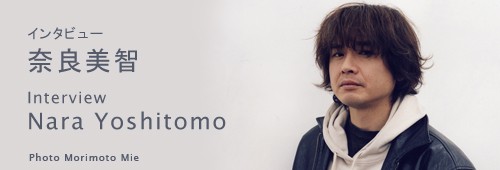
Nara Yoshitomo is currently taking part in APT 6 as YNG (Yoshitomo Nara and graf), presenting an arresting combined effort that catches the eye immediately on entering the soaring space of Brisbane’s Gallery of Modern Art. Built on a well-used minivan, it is also the latest work in the artist’s ‘hut’ series launched in 2003.
Interview/text: Hara Hisako
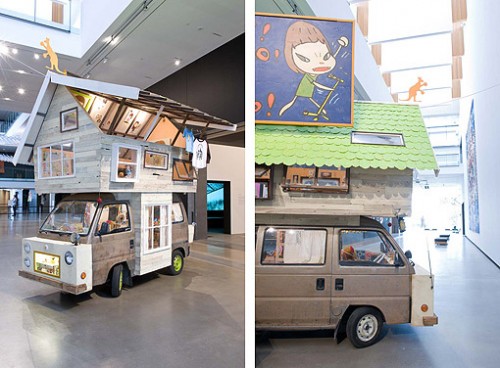 YNG Y.N.G.M.S. (Y.N.G.’s Mobile Studio) 2009
YNG Y.N.G.M.S. (Y.N.G.’s Mobile Studio) 2009Installation views at the 6th Asia Pacific Triennial of Contemporary Art, Queensland Art Gallery, Gallery of Modern Art, Brisbane 5 December 2009 – 5 April 2010 Photos Natasha Harth
Courtesy Queensland Art Gallery, Gallery of Modern Art Collection Queensland Art Gallery
– Can you begin by explaining the lead-up to the creation of Y.N.G.M.S. (Y.N.G.’s Mobile Studio), your work at this year’s APT?
I started by sketching ideas that came to me following a visit to Brisbane for some groundwork, and we stayed pretty much faithful to that initial concept. The narrative of a ‘mobile studio coming from faraway Japan to journey across the vast Australian continent’ just naturally evolved.
Using a motor vehicle was not a new development. I try to experiment with new things each time, so in that sense it’s on the same level as always. On this occasion the curator directed us to a space where the ceiling was open to three floors up. So the idea of making something tall occurred immediately. Plus I was mindful of several locations on the upper floors where it would be possible to view the work from above. Once again I’ve joined forces with Toyoshima Hideki and co. People’s perception of Australia is of kangaroos and koalas, and the world of Mad Max, and I suspect my idea of a work on wheels also owes something to hazy notions of a near future populated by people tearing about in modified vehicles.
A mobile studio to paint in anytime, anywhere
As well as that, on a personal note, I’ve been listening to a lot of ’70s music lately. And when one of those artists – Small Faces bassist Ronnie Lane – went solo, he used his own funds to build a mobile studio. Reportedly used by artists including Eric Clapton, word has it this was an amazing facility crammed with every kind of sound recording gear, set up to do anything you wanted. Our installation for APT 6 is also partly inspired by the idea of this mobile studio, I think. I move around a lot, to exhibitions in various places, and residencies, and it struck me that if I possessed a movable studio like this, I could paint anytime I wanted. So I suspect the work for APT is also a tangible expression of my desire for something like that. I didn’t just intuitively think ah, something on wheels would be good; actually there were various reasons for it.
I used patchwork for the interior around the driver’s seat, a little ’70s inspiration. If a car with an interior like that really existed, I’d love to have one.
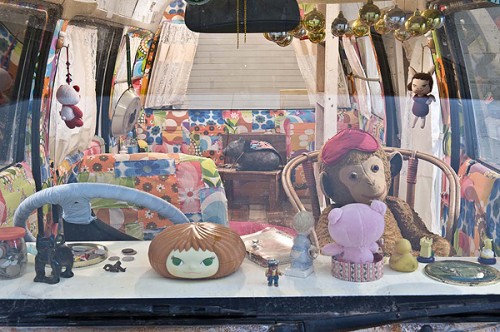 YNG Y.N.G.M.S. (Y.N.G.’s Mobile Studio) (detail) 2009
YNG Y.N.G.M.S. (Y.N.G.’s Mobile Studio) (detail) 2009Photo Natasha Harth Courtesy Queensland Art Gallery, Gallery of Modern Art Collection Queensland Art Gallery
– I note also that YNG contributed a little room for the Kids’ APT program, for children to come in whenever they feel like and do some drawing.
That was actually a proposal from the curator running Kids’ APT; personally I don’t feel there’s any special need for programs targeting children. When you think about it, children have no experience of life’s sufferings, or romantic love, so even when they do feel emotions – joy, anger, sorrow etc. – they’re incapable of analyzing them very deeply. I left it up to the curator and just lent a hand. They said they wanted to play some punk music – a favorite of mine – in the room, and asked me to put together a selection. But the lyrics of the more aggressive tracks can be pretty crude. I asked if that was OK and they initially said ‘no problem’, but when I’d burned a CD and handed it over they then decided that no, perhaps it wasn’t OK after all. Occasionally, in the process of being seen to do the right thing, an artist’s originality can be lost.
People in Queensland are generally fairly well off, and children who visit art museums are especially familiar with this sort of program. GoMA asked me to run workshops and so on, but I declined. It just struck me that if I had to provide activities for children, I’d rather work with kids in Thailand helping them make papier-mache dogs, that kind of thing.
In recompense you might say, though that sounds a bit odd (laughs), I let them use my picture of a wombat on the staff T-shirts and as the Kids’ APT mascot.
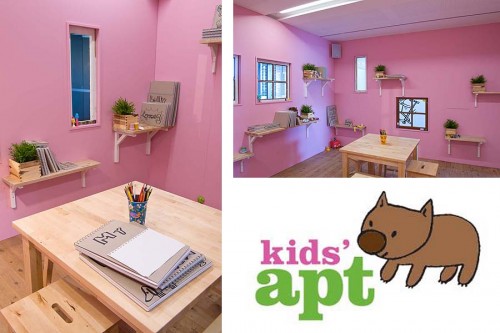 Left and upper right: YNG The cubby house 2009
Left and upper right: YNG The cubby house 2009Installation views at the Kids’ APT, Queensland Art Gallery, Gallery of Modern Art, Brisbane 5 December 2009 – 5 April 2010 Photos Natasha Harth Courtesy Queensland Art Gallery, Gallery of Modern Art
Lower right: Wombat the Kids’ APT mascot
Journeys in search of, journeys to retrieve
– What are your thoughts right now on the idea of ‘journeys’ conjured up so powerfully by Y.N.G.M.S.?
Journeys that move us from where we are now are to my mind a mixture of unease and anticipation concerning what might be on the other side. We may lose things in the process of moving forward, but we actually make a lot of discoveries too. That for me is what a journey means. Journeys in my 20s were all about expectations. It feels now as if I’m picking up what I dropped along the way back then.
My recent journeys have been prompted by a wish to see more places from back when I was simply me. For about ten days over New Year this year I returned to my old family home in Hirosaki (Aomori). It was ages since I’d spent the New Year holiday there, not to mention so much time alone with my mother, but in being away from things like work, authority, I think I succeeded in retrieving something precious.
Cities like Berlin, Paris, New York, and Tokyo are in a sense mere fictions, and though the art itself ought to be paramount, you can end up chasing other things. It’s become very important to me of late to retrieve some of the precious things I’ve left behind in places a world away from the city.
– Having taken part in your first APT, what are your impressions of the show? One major feature of it must be the way it attracts artists from all around the Asia-Pacific region.
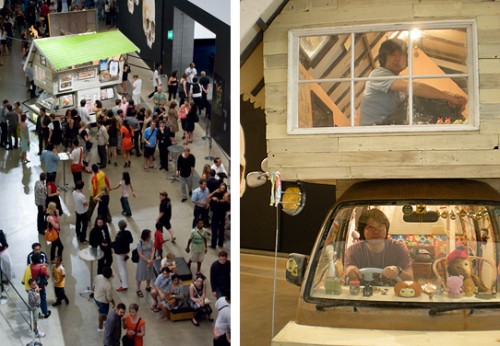 Left: YNG Y.N.G.M.S. (Y.N.G.’s Mobile Studio) 2009
Left: YNG Y.N.G.M.S. (Y.N.G.’s Mobile Studio) 2009Installation view at APT6 Photo Natasha Harth
Courtesy Queensland Art Gallery, Gallery of Modern Art Collection Queensland Art Gallery
Right: Nara and Toyoshima Hideki Courtesy the artists
Although I didn’t sense it when showing earlier at the Museum of Contemporary Art in Sydney, it struck me this time that while Australia is a country built by Western immigrants, it has a different mindset to what you find in Europe or the US. I wasn’t even conscious of it last time, but this time I sensed how perfectly Australia fits into the ‘Asia-Pacific’ mold. Its location in the Asia-Pacific region means it’s closer in spirit to countries there than to its Western counterparts in the Northern Hemisphere. There are the Aboriginals, and lots of Asians; the lead curator Suhanya was herself a Sri Lankan immigrant. So you have a Western context overlaid with a variety of mentalities.
Unlike other international shows, APT does not fit into the American or European context at all; it struck me as more akin to a regional art festival on a grand scale. ‘Regional’ usually refers to something small, but here one was very aware of the Asia-Pacific as one big region. Even in Asia, when I receive proposals from the new breed of museums in places like Beijing and Shanghai I tend to stall, because I can just visualize them already thrilled at the thought of the profits. I’d rather not be appraised in any way that involves places like that bestowing authority on me. I’m more interested in presenting my work in other Asian countries, no matter how small the event.
To me Asia still has that neighborliness, that intimacy I remember from the Japan of my childhood. I guess it comes down to the fact that people in Asia still forge proper connections with others in their day-to-day lives.
Nara Yoshitomo
Born 1959 in Hirosaki. Received his MA from Aichi Prefectural University of Art and Meisterschueler from the Kunstakademie Dusseldorf. Became Guest Professor at the University of California, Los Angeles (UCLA) in 1998. Based in Japan since 2000. His creative practice expresses itself a wide range of media including painting and drawing, for which he is best known, as well as sculpture and installation. He is participating in APT6 under the moniker YNG, representing his collaboration with Toyoshima Hideki and other former members of the design unit graf, known for their free-form series of installations combing hut-like buildings and groups of Nara’s works. Plans for 2010 include solo shows at Tomio Koyama Gallery in May, and the Asia Society New York in September. He is exhibiting in Garden of Painting – Japanese Art of the 00s through 4 April at the National Museum of Art, Osaka.
< Back to Index: "The 6th Asia Pacific Triennial of Contemporary Art"
